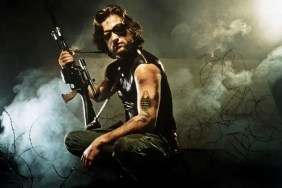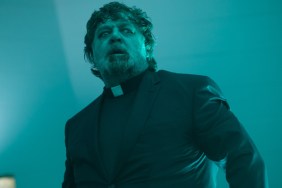A re-appraisal of John Carpenter’s often dismissed sequel Escape From L.A.
With news breaking over the weekend that genre movie innovator and digital deconstructionist Robert Rodriguez will be helming the remake of John Carpenter’s cult classic thriller Escape from New York, we thought it a good time to take a quick look back at Carpenter’s own sequel/sorta remake, 1996’s often dismissed or outright ignored Escape from L.A.
When Carpenter released the original Escape in 1981, the modestly-budgeted pulp action flick was a huge hit, both domestically and, surprisingly, in Europe (especially Italy) where, along with 1979’s Mad Max and its 1982 sequel, every savvy producer tried their hand at ripping it off. That Carpenter chased it with his biggest movie — and at that point biggest failing — 1982’s The Thing says much about the filmmaker’s creative and commercial trajectory. When Carpenter taps into the zeitgeist (Halloween), he’s a tastemaker. When he fails to do that, he’s simply ahead of his time. I don’t think he’s ever made a legitimate bad film. And yes, I am one of the few that cite Ghosts of Mars (which was originally written as the third Escape movie) as one of his best and most undervalued works.
RELATED: Kurt Russell on Playing Ego the Living Planet in Guardians of the Galaxy Vol. 2
The latter category of being ahead of its time is exactly where Escape from L.A. falls into. The ’90s were a notoriously dismal time for genre movies, due primarily to a generational shift. The odd bright spots to really define their times were things like Rodriguez’s 1996 horror hybrid From Dusk Till Dawn and Wes Craven’s same-year slasher send-up Scream. Even if you didn’t dig those pictures’ camp approach, they were unarguably fresh entertainments that locked onto what fans wanted and both — especially Scream — were huge hits, both catering to the kind of movies young people were interested in absorbing. Escape came out the same year as Scream, a sequel to a movie that, by 1996, was a bit played out, having long since cycled through its TV and video runs and a follow-up felt a bit late-out-of-the-gate. The original film cost $6 million to produce and despite its success, it pretty much remained a cult film. The character of Snake Plissken ( played by a young and hungry Kurt Russell) was not particularly ingrained into the mainstream pop culture subconscious and so when posters for Escape from L.A. were released, screaming “Snake is Back!”, many mainstream viewers were like, “Who the Hell is Snake?!”

The movie was released in August via Paramount Pictures, a summer movie that probably would have stood a better chance smashing into theaters in February, a dry season where a built-in cult title like this would have hooked its audience better. Instead the movie, which cost twice as much as the original earned (New York raked in 25 million whereas L.A. made the same but cost 50 million) and critics were lukewarm to it. Hardcore Escape from New York fans were generally divided, with many just happy to see Russell’s one-eyed outlaw back on screen and many other sneering at what they thought was a too-campy approach.
And sadly, the ensuing years haven’t found Escape from L.A. many more admirers, with people almost universally citing it as inferior to its predecessor. And I get that. The original was raw. Messy. Angry. It swelled with innovation and urgency, another one of Carpenter’s neo-Westerns, an inversion of Rio Bravo. Escape from L.A., with its sunnier locales and a narrative repeat of the original’s city-as-a-prison gimmick is, on the surface, a bit lazy, true. But 20 years later, L.A. not only holds up beautifully as a high-octane romp, it’s a bit of a marvel; a tough, shiny, comic book fantasy with broad performances, a to-die-for cult cast, outrageous set pieces and, most importantly, sharp social criticism that is infinitely more potent and prophetic today than it was in 1996.
The film stars Cliff Robertson as a President who, after being “elected for life” has deemed to Make America Great Again by shipping off every person he deems “undesirable” to L.A., which, due to a massive earthquake and flooding, has become an island. Stripped of their citizenship, this mixed bag of “morally unfit” Americans run wild, setting up micro-civilizations, most of them bewildered by a country that has forsaken them. Among their ranks is charismatic revolutionary Cuervo Jones, who has charmed the President’s comely daughter via the internet (or at least a holographic version of the internet) into stealing a classified weapon that has the power to effectively disable every electronic device on the planet. If triggered, Earth would essentially revert back to an instant stone age.
Enter our man Plissken, played here with even beefier swagger by Russell, who in 1981 was a young actor emerging from a life as a teen star (thanks in no small part to Carpenter who directed him in the amazing 1978 Elvis TV movie) and by this time was a bona fide Hollywood movie star. Plissken version 2.O. feels angrier, rougher and closer to Clint Eastwood/John Wayne hybrid he was conceived to be in the original (Russell actually co-wrote the script with Debra Hill and Carpenter). Sentenced to life imprisonment in LA, the President offers the grizzled outlaw a full pardon if he can get into L.A. and retrieve the weapon. To ensure his compliance, Plissken is injected with a deadly virus that will kill him in 10 hours if isn’t successful in his mission. Soon, Plissken is outfitted with weapons and gadgets and shot into the prison city, where he meets all manner of eccentrics (including Steve Buscemi as a lovable grifter tour guide, Bruce Campbell as a psychotic plastic surgeon, and Pam Grier as a transgendered assassin) before facing off against the righteously vengeful but megalomaniacal Jones.

No matter your take on Escape from L.A.‘s social themes or success as an action picture, only the coldest, deadest heart would deny that the movie is anything but a tsunami of pure escapist fun. I mean, Russell future-surfs with Peter Fonda for crying out loud! Carpenter himself has cited that the movie is a better film in every way to the original and he’s right in that this a much bigger and ambitious picture. But fans of the original loved seeing actors like Donald Pleasence, Issac Hayes, Harry Dean Stanton, Ernest Boirgnine, Adrienne Barbeau and Lee van Cleef flail around in what was a really, really grimy movie. L.A. is not the urban sleaze-fest that was New York. The actors here are clean, the trappings garish and circus-like. And of course, the sets are considerably pricier. But taken on its own terms, it all makes sense. Viewed as a jacked-up, sun-baked remake of the original, it works perfectly.
And the satire is on point. Carpenter sticks it to L.A. but good, showing a city whose shallowness and ego has mutated to lethal levels when left unchecked. And the very idea of a weapon designed to destroy technology is even more potent today, where we are so addicted and reliant on electronics that if we ever lost our power over it, our collapse would be just as swift as it would be via nukes or gas or disease. And have we mentioned the music? Carpenter’s iconic synth-based Escape from New York theme is wonderfully rocked-out with the aid of the late, great Shirley Walker and both that theme and the entire score are fantastic.
If you’re one of the fans who have filed Escape from L.A. way back in your Carpenter Rolodex, we urge you to dig it up and give it another look. It’s one his strongest non-horror films…









